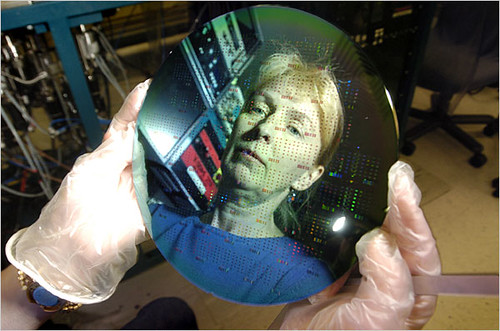
Smaller memories ?
 IBM, Qimonda and Macronix have announced that they have jointly developed a new kind of material that holds promise for new computer memory chips being available for the mass market. They created a new semiconductor alloy derived from materials currently used in optical storage devices like CDs and DVDs. This falls into the category of non-volatile memories, which IBM believes could enhance the speed of microprocessors. It could also be used for a vast array of devices like mp3 players, video, etc.
IBM, Qimonda and Macronix have announced that they have jointly developed a new kind of material that holds promise for new computer memory chips being available for the mass market. They created a new semiconductor alloy derived from materials currently used in optical storage devices like CDs and DVDs. This falls into the category of non-volatile memories, which IBM believes could enhance the speed of microprocessors. It could also be used for a vast array of devices like mp3 players, video, etc.
Ancient "Luna-tic" machine.
![]() Scientists recently announced that they have been able to understand the delicate workings of a
Scientists recently announced that they have been able to understand the delicate workings of a ![]() 2000 year old computer used by ancient Greeks to calculate lunar cycles. Named the "Antikythera mechanism", it was discovered over a 100 years ago in a Roman shipwreck. It could also track solar and planetary positions. It could have been used to time agricultural and religious festivals.
2000 year old computer used by ancient Greeks to calculate lunar cycles. Named the "Antikythera mechanism", it was discovered over a 100 years ago in a Roman shipwreck. It could also track solar and planetary positions. It could have been used to time agricultural and religious festivals.
Welcome to the "Dark" side
 Scientists have discovered anti-gravity...not, not the one from science fiction lore, but dark energy. Apparently, after the big bang, the cosmos behaved like there was was serious anti-gravity at work that forced it to expand -- this was known as dark energy. A group of astronomers, using the Hubble space telescope, have found that billions of years before this antigravity overcame the cosmic gravity, it was already present and was shaping the evolution of the universe.
Scientists have discovered anti-gravity...not, not the one from science fiction lore, but dark energy. Apparently, after the big bang, the cosmos behaved like there was was serious anti-gravity at work that forced it to expand -- this was known as dark energy. A group of astronomers, using the Hubble space telescope, have found that billions of years before this antigravity overcame the cosmic gravity, it was already present and was shaping the evolution of the universe.
A Large lens
The European Southern Observatory (ESO) has approved the construction of what will be the world's largest telescope, the European extremely large telescope (E-ELT). Costing Euros 57 million, it will have a mirror with a diameter of 42 meters, and is composed of 906 hexagonal segments, each 1.45m in size! Now if only they could use some of their intelligence to think of an original name !
_______________
No comments:
Post a Comment